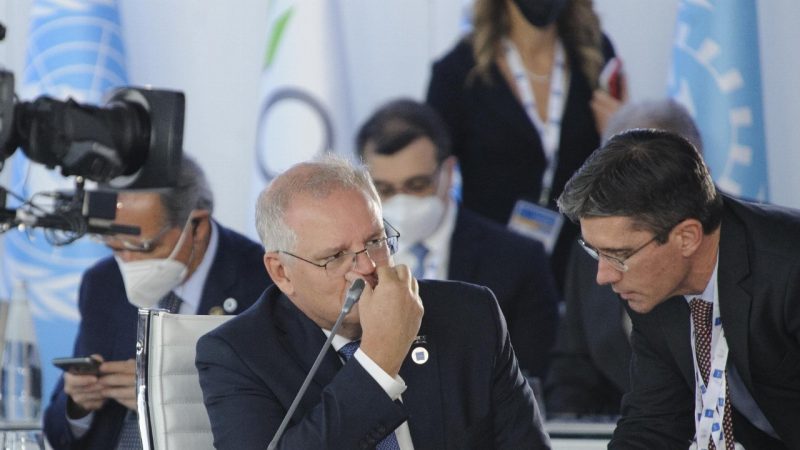- Prime Minister Scott Morrison is under growing pressure to boost short-term objectives and phase out coal power as he travels into the COP26 meeting in Glasgow
- Progressive think tank, The Australia Institute, has taken out advertisements in Scottish newspapers urging world leaders to stop Australia ‘derailing’ climate talks
- Prime Minister Scott Morrison defended Australia’s position, using his final remarks at the G20 meeting in Rome to say Australia has made its “position very clear”
- According to the Grattan Institute, Australia must act immediately to increase its rate of carbon emission reductions, or it would have little chance of reaching net-zero by 2050
As Prime Minister Scott Morrison flies into the COP26 summit in Glasgow, he is under increasing pressure to raise short-term goals and phase out coal power.
Full-page advertising in Scottish newspapers will welcome Prime Minister Morrison, with a photo of him in parliament holding a lump of coal and a plea to world leaders not to allow Australia to ‘wreck’ climate talks, thanks to the progressive think tank, The Australia Institute.
Pressure for increased targets has been growing in recent weeks. After being stalled by the National Party, the Morrison Government formalised a net-zero emissions plan by 2050 last week.
The plan was released just before the COP26 summit and focuses on “technology not taxes”. Opposition leader Anthony Albanese criticised the government for not legislating net-zero into law.
Yesterday, the United Kingdom’s top climate advisor Lord Deben rubbished the plan, telling the BBC there was “no indication” that Australia has a plan to deliver on the plan that was “squeezed out of him [Morrison]”.
Former executive secretary of the UN Framework Convention on Climate Change and a key diplomat in the 2015 Paris Agreement told the ABC she struggles to “find an adjective that is politically correct” for Australia’s climate goals.
Prime Minister Scott Morrison defended Australia’s position, using his final remarks at the G20 meeting in Rome to say Australia has made its “position very clear” but that he will only speak for Australia, and not other countries.
At a press conference yesterday, Mr Morrison said only four countries around the G20 table have had a “larger reduction in emissions since 2005 than Australia”.
“We’re getting it done, we’re 20 per cent more down already on our emissions and our path is going to be set by technology,” he told reporters.
“If we hit those technology targets that are set out in the Australian way plan, then net zero by 2050, is something that not only Australia can achieve but so many other countries as well.”
The Australia Institute climate and energy program director Richie Merzian said Australia needs to explain to its global allies how it will achieve net zero in a plan that allows for new gas and coal projects.
“The Australian Government is being perceived as a protector and promoter of coal,” he said.
“Australia is unwittingly providing cover to other G20 major emitters like China and Brazil, that are also refusing to increase short term targets and efforts.”
To kick things off the @Sunday_Post – Scotland's biggest paper – has a special pullout covering #COP26
— Richie Merzian (@RichieMerzian) October 31, 2021
So @TheAusInstitute took out a full page with a message to world leaders on Aus Gov's commitments…. pic.twitter.com/Xow4vmFs3h
In an interview with ABC Insiders, the Minister for Industry, Energy, and Emissions Reduction, Angus Taylor said the government’s plan achieves net zero while avoiding collateral damage.
“Our view, from the work we’ve done, is we can get the cost of low-emissions technologies to a point where they’re cost-competitive in reasonable time-frames that will allow us to get to net zero by 2050,” he said.
“We’ve laid out the funding for that pipeline over the next 10 years, which is a much longer time period than governments would normally do.”
However, according to a new analysis from policy think tank Grattan Institute, Australia must act immediately to increase its rate of carbon emission reductions, or it would have little chance of reaching net-zero by 2050.
“The world has seen through the Australian Government’s net zero target,” Mr Merzian said
“Without putting an end to new gas exploration and new coal mines such as the Adani mine and opening the Beetaloo Basin, and a transition plan to power our nation with renewable energy, Australia’s net zero by 2050 target is a fraud.”

